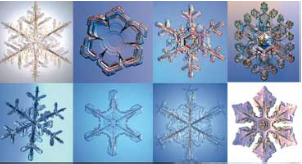


Ronald Modra´s Legacy

Tell me why
Why do snowflakes have 6 sides?
By R.M.R. (Published in El Guardián Mundial Edition 3,
page 24)
One of the most beautiful and organized objects found in nature is the snowflake. It is impossible to register,
even by computer, all of the designs possible in a snowflake. In an average snow-storm billions or trillions of
snowflakes fall yet no two of them are exactly alike.
Snow may be a form of frozen water, but it appears to be white, which is caused by the many reflecting sides
and because air is trapped. It may be thought of as finger-prints of nature.
When water freezes it forms crystals, and they conform to a cosmic law of special mathematical arrangements. The water molecule consists
of three units, two atoms of hydrogen, and one of oxygen, so this gives us one clue as to why snowflakes have six sides, because it can
only have three or six sides in this atomic arrangement, as far as our knowledge of mathematics reaches.
In certain conditions the water freezes in the air from the vapor that is present. These crystals are so small that they are carried in the
air, rising and falling with air currents. During this activity groups of these geometric crystals gather around a speck of dust, or anything in the air that they can use to create an epicenter; something to begin their accumulation. The group of water crystals becomes larger as hundreds or thousands of them interlock, becoming a snowflake. When the growing combination of crystals becomes large enough it slowly floats downwards, because now the effect of gravity overcomes the air currents. It now falls as a snowflake and accumulates on the ground as snow and may melt or become solid depending upon the ground level temperature.
The size of a snowflake depends on the air temperature. The colder the temperature, the smaller the snowflakes, because they consist of more water and less air in their combination, but other factors are involved, e.g. weight, wetness and adhesive ability.
In many parts of the world snow has fallen that is not white and has been recorded in the colors of blue, green and red, even black. This is considered to be caused by either dust or fungi in the air at the time crystals were forming. We do not know very much about cosmic dust which is also present and may play a role in both water droplet formation and snowflakes.
Interestingly, although we refer to water as “simple,” water, snow and ice cannot be made in artificial form by mixing the atoms of hydrogen and oxygen. Science can change it from one form to another e.g. ice to vapor and back again but no process or machine can be made to produce water by combining hydrogen and oxygen in such a way as to produce a stream of water. We must rely on nature to produce it, and we must direct it, store it and use it wisely, especially in arid areas. Even though hydrogen and oxygen exist everywhere, we must still work cooperatively with nature itself to procure a water supply, sufficient to support all life systems.
We just do not have creative powers over water, ice and snowflakes, except to cause them to alter their form and it is not likely that we can destroy water either, but that is quite a big subject to be discussed at another moment.
Language English
Idioma Español



Diseño página web: Andrea Santander



